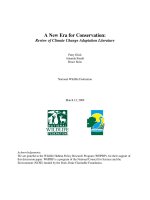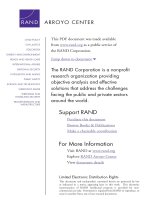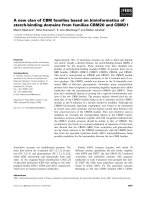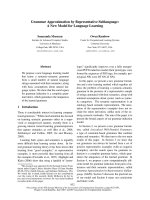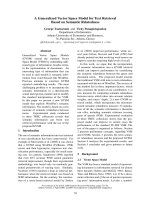A New Model for Network Traffic Based on Alpha Stable Self similar ...
Bạn đang xem bản rút gọn của tài liệu. Xem và tải ngay bản đầy đủ của tài liệu tại đây (91.61 KB, 5 trang )
A New Model for Network Traffic Based on Alpha-Stable Self-similar Processes
Ge Xiaohu, Zhu Guangxi, Zhu Yaoting
Department of E & I, Huazhong University of Science & Technology, Wuhan, China, 430074
Abstract-This paper proposes a new network traffic
and call them H-sssi processes [4]. Self-similarity
model based on alpha-stable processes. Then the traces of
manifests itself in a number of equivalent ways, the most
three
simulated.
relevant of which is the display of the Long Range
Comparing the traces of the simulation data and the trace
Dependence (LRD) for H-sssi processes. Mandelbrot
of the actual data, it is shown that the new model is better
refers to this phenomenon as the Joseph effect. Another
than the other models in fitting with the actual data.
important way of self-similarity is high variability for
different
self-similar
models
are
Key words: communication, network modeling, self-similar,
Noah effect.
alpha-stable processes
1.
H-sssi processes. Mandelbrot refers to this phenomenon as
INTRODUCTION
Recent empirical studies of high-resolution traffic
measurements from a variety of different working
communication networks have provided ample evidence
that actual network traffic is self-similar or fractal in
nature [1][2], which couldn’t be modeled by Poisson and
Markov processes or variants of them. For example,
people have discovered that overall packet-loss decreases
very slowly with the increasing of the buffer capacity, in
sharp contrast to Poisson-based models where packet-loss
decreases exponentially fast while the buffer size increases.
Moreover, packet-delay (95th percentile) always increases
with the increasing of buffer capacity, again in contrast to
the Poisson models where packet-delay does not exceed a
fixed limit despite the increasing of the buffer size. As a
result, some routers and protocols designed by the Poisson
model produce negative effect on network traffic. So it is
necessary to explore a new model which can capture the
self-similarity.
The term “self-similar” was firstly used by Mandelbrot
[3] during the 1960’s to designate those processes that are
scalable over time (or space) without losing their
statistical properties. In other words, a continuous-time
process
X = {X (t ), t ≥ 0}
is
self-similar,
with
self-similarity parameter H, if it satisfies the condition:
d
X (t ) = c −H X (ct), ∀t ≥ 0, ∀c > 0, 0 < H < 1 (1)
There are many different self-similar processes. We
typically consider those that have stationary increments,
Since the discovery of the self-similarity in network
traffic, many models have been put forward to describe the
self-similar network, which include the ON-OFF model,
the FBM model, the FARIMA model, the S4 model and so
on [5][6]. But they all have some drawbacks. The
hypotheses of the ON-OFF model are inconsistent with
the fact. The FBM model can’t capture features of the
burstiness.
Because
the
FARIMA
model
is
too
complicated, it is impossible to use it for real-time
simulation. It is difficult for the S4 model to describe the
LRD. Therefore, it is important to find a new model of
network traffic, which can exhibit the Joseph, the Noah
effects and parsimonious parameters.
Because of the infinity of sample variance caused by
the LRD, the actual network traffic modeling could not
use the central limit theorem. But the generalized central
limit theorem could be used, since it states that if the
marginal distribution of the normalized aggregation of
infinitely many independent and identically distributed
(i.i.d) sources converges, then it belongs to the family of
alpha-stable marginal distributions, which have in general
infinite variance [4]. Therefore the authors try to model
the network traffic based on the alpha-stable processes.
The material and contributions of the paper are
organized as follows. In Section 2 the basic properties of
alpha-stable distributions and the concept of Linear
Fractional Stable Motion (LFSM) processes are introduced.
The new model proposed is submitted in Section 3. Some
analyses and comparisons are delivered in Section 4. In
the conclusion part the authors summarize the main
its characteristic function is
observations and refer to future work.
2.
{
E exp i θ X = exp − σ 2 θ 2 + i µθ
ALPHA-STABLE DISTRIBUTION AND LINEAR
}
(3)
It is the FBM process. So the alpha-stable process
FRACTIONAL STABLE MOTION
includes all properties of the FBM process, at the same
2.1 The Definition and Properties of the Alpha-stable
Distribution
Since densities and distribution functions are not
time it has properties of non-Gaussian case.
Tail Approximation: Let X ~ Sα (σ , β , µ ) with
0 < α < 2 , then, as
known in closed form for most stable distributions, they
α 1 + β C x −α
α
P {X > x } ~ σ
2
P {X < − x } ~ σ α 1 − β C x −α
α
2
are generally specified by their characteristic functions.
Definition [4] 1: A random variable X is said to have a
stable
distribution
if
there
are
0 < α ≤ 2, σ > 0, − 1 ≤ β ≤ 1 , and µ ∈ R
parameters
so that its
characteristic function has the following form:
α α
πα
exp− σ θ 1 − iβ (signθ ) tan + iµθ
2
E expiθX = if α ≠1
exp{− σ θ (1 + iβ (signθ ) lnθ ) + iµθ}
if α =1
Parameter α
1−α
Γ ( 2 − α ) cos( πα / 2 )
Cα =
2
π
(4)
if
α ≠1
if
α =1
So alpha-stable distributions have the property of heavy
tailed.
2.2 The Linear Fractional Stable Motion
(2)
There are different extensions of fractional Brownian
motion to the alpha-stable case. The one that is most
if θ > 0
if θ = 0
if θ < 0
1
signθ = 0
− 1
x→∞
commonly used is the LFSM process [4].
The
well-balanced LFSM processes are continuous-time
stochastic processes
is called characteristic exponent and
specifies the level of burstiness in the distribution. The
distribution can be skewed if the skewness parameter β
is different with zero. α and β together determine the
shape of the distribution. Variables σ and µ are called
follows:
{Lα ,H ,−∞ < t < ∞}
(
defined as
)
H−1/α
H−1/α
∞
Lα,H (t) = ∫−∞ (t − x)+
− ((− x)+ )
⋅ Ms (dx) (5)
Where 0 < α < 2 , 0 < H < 1 , H ≠
1
α
, and M s is an
the dispersion and the mean or median of the distribution.
alpha-stable random measure on R
with Lebesque
A random variable X
that follows an alpha-stable
control measure. The new network traffic model advanced
distribution with the above parameters is denoted by
X ~ Sα (σ , β , µ ) .
in this paper is based on the Linear Fractional Stable Noise
scale and location parameters, respectively, and express
If α = 2 , the alpha-stable distribution reduces to the
Gaussian distribution (the parameter is β nonexistent),
(
)
N α' , H ( i ) = h d ∗ S σ( α, β) , 0 ( i )
∑
Km
=
k =1
h d (k / m
)
S σ( α, β) , 0
(LFSN) processes, and the LFSN processes are the
increment processes of the LFSM processes. The
discrete-time LFSN processes are given as follows:
x d − ( x − 1 )d
hd ( x ) =
x d
(i − k / m )
(6)
d = H −1/α .
if
1< x
if
0< x ≤1
.
It is said that the LFSN processes are the LRD if H >
α
,
positive real constants,
−1 < β < 1
, and
Nα'' , H (i )
.
expresses the discrete-time trace of 1-stable LFSN. S1(,α1,)0
THE NEW MODEL OF NETWORK TRAFFIC
~
and S1(,α1,0) are two i.i.d random variables with common
or the Short Range Dependence (SRD) if H <
3.
1
1
α
In order to capture the changes of network traffic,
based on the LFSN processes and its property of stability,
distribution Sα (1,1,0) .
this paper brings forward a new network traffic model.
The form is as follows:
M (i ) = c1 N α , β , H (i ) + c 2
(
c
h
= 1 d
∗
ANALYSIS AND COMPARISON
In order to analyze the performance of the new model, the
''
= c1 h d ∗ S
4.
(α )
1, β ,0
actual network data (file Oct89Ext.TL) is used for comparison,
)( i ) +
which was collected by Leland at Bellcore Morristown Research
c2
1 + β 1 / α (α )
S 1 ,1 , 0
2
(i)
1/α
~ (α )
− 1 − β
S 1 ,1 , 0
2
and Engineering facility [2].
The data file contains 1,000,000 packets of network traffic.
All packets are divided into ten data sets each having 100,000
packets, and then the number of packets passing in a range of ten
(7)
seconds in every data set is counted. Thus ten new data sets are
obtained, in each of which every element expresses the number
of passing packets in 10s time scale. The quantile method is used
+ c2
where M (i ) denotes the volume of traffic carried by the
for estimating parameters of the new model in every new data set
[7]. Consequently the Table.1 is got as the results of estimation.
network element in the time unit i , c1 and c 2 are
Table.1. The parameters of alpha-stable processes measured by actual network data.
Data sets
Sequence of packets
α
β
σ
µ
1
1~100000 packets
1.3635
1.0000
13.5331
4.8294
2
100001~200000 packets
1.4921
1.0000
36.5022
39.6485
3
200001~300000 packets
1.8455
1.0000
55.8680
112.9420
4
300001~400000 packets
1.3322
0.8869
49.3299
156.1060
5
400001~500000 packets
1.3244
0.6699
33.7254
149.0870
6
500001~600000 packets
1.5603
0.5527
63.6562
244.4920
7
600001~700000 packets
1.4265
1.0000
51.9600
134.7900
8
700001~800000 packets
2.0000
48.7472
92.0000
9
800001~900000 packets
2.0000
26.2082
26.0000
10
900001~1000000 packets
1.5480
20.9367
1.8193
1.0000
In order to demonstrate the predominance of the new
network traffic, the simulated trace of the new model, the
model through experiments, the fifth data set of table.1 is
simulated trace of the S4 model and the simulated trace of
stochastically selected as the target for simulation. For
the FBM model. By comparing the traces in Fig.1, it is
convenience in comparing, the FBM model, the S4 model
shown that the FBM model trace can’t describe the
and the new model are respectively used to generate the
burstiness of network traffic, however the S4 model trace
simulation data. Fig.1 includes the trace of the actual
and the new model trace can capture the burstiness.
Although the S4 model can capture the burstiness, the
of the mathematic model can provide the theoretic
scale of the burstiness of the S4 model is about 10000 to
foundation of assigning network resource, improving
30000. The scale of the burstiness of the new model is
traffic efficiency and guaranteeing Quality of Service
about 1000 to 2000. The scale of the burstiness of the
[6][7].
actual trace is about 1000. So the error of the S4 model is
This paper introduces the definition and properties of
larger than the new model. Therefore it is said that the new
the alpha-stable distribution, and then a new model is
model is better than the other models in fitting the actual
advanced based on the LFSN processes. In terms of
packets of network traffic. So the new model can provide
comparing the simulation traces of the three models with
great advantages in the future research.
the actual network data, it is shown that the new model is
5.
better than the other models. In the future we will research
CONCLUSION
The significance of network traffic modeling is to
design a mathematic model, which can mimic the trends
a method of prediction based on the new model for
assigning network resource.
observed in measured data. Consequently, the prediction
1200
1000
packet
800
600
400
200
0
0
100
200
300
400
500
400
500
(A) time (10second)
1800
packet
1300
800
300
-200 0
100
200
300
(B)
time (10second)
30000
packet
25000
20000
15000
10000
5000
0
0
100
200
(C)
300
400
time (10second)
500
400
packet
300
200
100
0
1
101
201
301
(D) time(10seconds)
401
501
Fig.1. The (A) plot is the actual trace; the (B) plot is the trace generated by the new model; the (C) plot is the trace generated by the S4
model; the (D) plot is the trace generated by the FBM model.
REFERENCES
[1] Orenstein, P.; Kim, H.; Lau, C.L. “Bandwidth
[6] Narasimha, R.; Seungsin Lee; Rao, R. “Discrete-time
allocation for self-similar traffic consisting of multiple
scale invariant systems: relation to long-range dependence
traffic classes with distinct characteristics”, Global
and FARIMA models, Acoustics, Speech, and Signal
Telecommunications Conference, 2001
Processing”, 2002 IEEE International Conference on,
[2] W. E. Leland, M. S. Taqqu, W. Willinger, and D. V.
Volume: 4, 2002.
Wilson, “On the self-similar nature of ethernet traffic”
[7] Nolan, J.P., Panorska, A. K. and McCulloch J. H.
(extended version), IEEE/ACM Trans. Networking, vol. 2,
“Estimation of stable spectral measures”, to appear in
pp. 1–15, Feb. 1994.
Math. Computer Modelling, 1996.
[3] B.B.Mandelbrot and J.W. Van Ness. Fractional
[8] Pitts, J.M.; Schormans, J.A.; Woolf, M.; Mondragon,
Brownian Motions, Fractional Noises and Applications.
R.J.; Arrowsmith, D.K., “End to end performance in real
SIAM Rev., Vol. 10, pp.422-437, 1968
time IP networks with self-similar behaviour, Acoustics,
[4] G. Samorodnitsky and M. S. Taqqu,
Stable
Speech, and Signal Processing”, 2002 IEEE International
Non-Gaussian
U.K.:
Conference on , Volume: 4 , 2002.
Random
Processes.
London,
Chapman & Hall, 1994.
[9] Yunkai Zhou; Harish Sethu, “On the effectiveness of
[5] Anestis Karasaridis, and Dimitrios Hatzinakos,
buffer sharing in multimedia server network switches with
“Network Heavy Traffic Modeling Using
self-similar traffic, Communications”, 2002. ICC 2002.
Self-Similar
Processes”,
IEEE
α -Stable
TRANS
COMMUNICATIONS, VOL. 49, NO. 7, JULY 2001
ON
IEEE International Conference on , Volume: 4 , 2002
